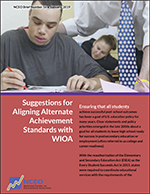 With the reauthorization of the Elementary and Secondary Education Act (ESEA) as the Every Student Succeeds Act in 2015, states were required to coordinate educational services with the requirements of the Workforce Innovation and Opportunity Act (WIOA). Although states had already begun this work by aligning their English Language Arts (ELA), mathematics, and science standards with college and career readiness, there were questions about how to meet the requirements outlined in the 2016 assessment regulations for alternate assessments based on alternate academic achievement standards (AA-AAAS).
With the reauthorization of the Elementary and Secondary Education Act (ESEA) as the Every Student Succeeds Act in 2015, states were required to coordinate educational services with the requirements of the Workforce Innovation and Opportunity Act (WIOA). Although states had already begun this work by aligning their English Language Arts (ELA), mathematics, and science standards with college and career readiness, there were questions about how to meet the requirements outlined in the 2016 assessment regulations for alternate assessments based on alternate academic achievement standards (AA-AAAS).
The National Center on Educational Outcomes (NCEO) with support from the Research and Training Center on Community Living (RRC-CL) published a Brief titled Suggestions for Aligning Alternate Achievement Standards with WIOA (NCEO Brief #16).
This Brief provides information on alternate achievement standards and WIOA, then makes several suggestions about ways to show that a student who meets a state’s alternate academic achievement standards is on track to pursue postsecondary education and integrated employment. In addition, several recommendations are provided for states to build a strong system to support the realization of the intent of ESSA and WIOA requirements for their students with the most significant cognitive disabilities.
